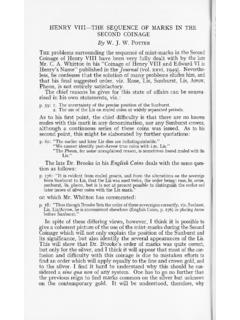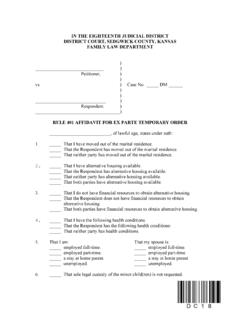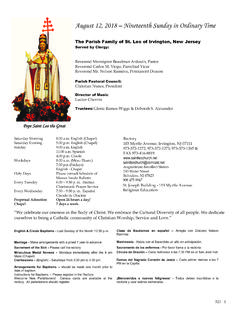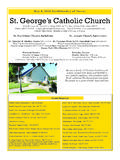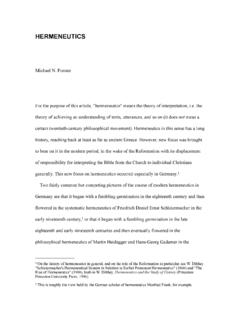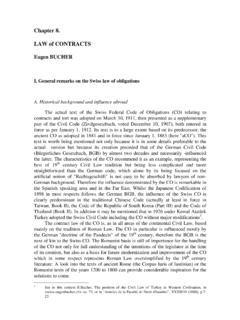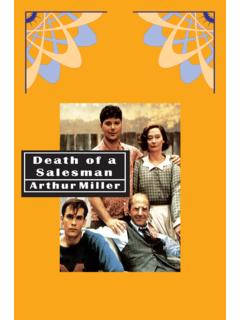Transcription of PROVINCIAL COIN-WEIGHTS IN THE EIGHTEENTH …
1 PROVINCIAL COIN-WEIGHTS IN THE EIGHTEENTH century NORMAN BIGGS Introduction IN 1745 T. Osborne, bookseller, offered for sale1 a magnificent work in three volumes, Browne Willis's Survey of Cathedrals. Presumably the work had not sold well up to that time, since the price was reduced from 2. 155. to two guineas. We can confidently assume that the bargain price attracted some buyers, but did they pay with two gold guineas? Or was the payment made with a number of silver coins ? Or was it a motley assembly of small foreign gold pieces and some worn silver exchanged at the bullion rate? The evidence of coin-scales and weights can throw light on such questions. A previous article2 traced the development of the making of COIN-WEIGHTS in London, where the virtual monopoly of the Founders Company was being eroded by the middle of the EIGHTEENTH century .
2 This article is concerned mainly with the trade outside London. The production of scales and weights was flour-ishing in Birmingham in the 1770s, where the making of COIN-WEIGHTS can be regarded as a pre-cursor for the copper coinages that started many years later, around 1787. The involvement of such luminaries as Matthew Boulton, James Watt and John Whitehurst lends a wider historical interest to the story. Indeed, by combining the documentary and artefactual evidence it can be shown that COIN-WEIGHTS were being made at the Soho Manufactory, as well as many other Birmingham establishments. Another sub-plot is the impact of the recoinage of gold in 1773-76. In theory this was intended to deter the circulation of light gold guineas, but in practice the circulation of Portugal gold was similarly restricted, although there is no reference to it in the official pronouncements.
3 The obvi-ous question arises: what are the implications for the economic dictum of Gresham's Law? The circulating medium One of the most significant aspects of the circulating medium in England in the middle of the EIGHTEENTH century was the predominance of Portuguese gold pieces. Important evidence is pro-vided by trade labels in boxes of coin-scales and weights, many of which have survived (PI. 8,1). Most of these labels contain a list of coins - the moidore, the johannes, the guinea, and their parts - each with its equivalent in sd, and its mass. (Details are given at the end of this section.) Surprisingly, this evidence was not always recognised by numismatists. An early volume of this Journal contained Lawrence's paper3 on COIN-WEIGHTS , the first devoted to the British series. Lawrence apparently based his paper on a small collection of weights (separated from their scales and boxes) and the documentary evidence collected by Ruding.
4 On that basis, he assigned to Ireland all the COIN-WEIGHTS for Portuguese gold, probably because there are several official proclamations declaring the tariff for these coins in Ireland, but none for England. In 1766 the true situation was clearly stated by Snelling, when he noted that no foreign silver or gold coin was cur-rent in England, except for the gold of Portugal, 'which however passes only by courtesy, and not by law'.4 Acknowledgements: I am indebted to Christine Biggs for trawling the pages of Aris's Birmingham Gazette, an exercise that pro-vided confirmation of many points that were previously only suspicions. Sincere thanks are also due to those who commented on drafts of the paper: Paul and Bente Withers. Diana Crawforth-Hitchins, Kevin Clancy, and Graham Dyer. 1 The advertisement immediately follows the index of Bishop Fleetwood's Chronicon Preciosum (London, 1745).
5 2 N. Biggs, ' COIN-WEIGHTS made by the Founders', BNJ 71 (2002), 111-18. 3 , 'Coin Weights', BNJ 6 (1909), 287-303. 4 T. Snelling, The Doctrine of Gold and Silver Computations (London, 1766), p. 69. PROVINCIAL COIN-WEIGHTS 103 The influx of Portuguese gold can be traced back to the first quarter of the EIGHTEENTH century : for example, it is recorded that the valuation of the moidores was already an issue in the West Country by The mechanism for the importation of these coins was the so-called Portugal Trade,6 powered initially by the different gold-silver ratios in England and Portugal. By 1742 the situation was serious. In that year, Peter Vallavine, vicar of Monkton in Kent, wrote that: It may be said that the Portugal coins are not the lawful Money of this Kingdom, and therefore we have no Business to concern ourselves about them. To this I answer, that these coins are now become in great Measure the current Money of the Nation; and though we are not obliged to receive them by the Law of the Land, we are forced to it by Necessity; and in all manner of Trade and Business a Man must take them or go without his We know that weights for checking the Portugal coins were being made in London in the 1740s.
6 In particular, there are some manufactured by John Kirk that are dated 1747. As well as his 'best' weights with finely engraved portraits (PI. 8, 2), priced at 2s. 6d. for the set of ten, he also made a set of plainer types, priced at Is. The traditional method of diminishing the coin was by clipping, and Vallavine had proposed a solution for this problem by use of edge-graining and other design features, not so different from the ancient long-cross. Unfortunately, although scales and weights provided an easy means of checking for illegally diminished coins , the complexity of the circulating medium provided other excellent opportunities for fraud. Clever forgers were able to produce coins with the correct mass, but lacking in fineness, and consequently with lower specific gravity than the true ones. These coins would pass the simple test of weighing, and could only be detected by more sophisticated means.
7 Their profusion soon led to the development of various forms of hydrostatic coin-scales: by weighing in air and in water, both the mass and the density of a coin could be determined. In a book written by William Symons,9 published in 1756, all the data required for checking guineas and Portugal pieces by this method were given (PI. 8, 3). In fact, one of the earliest pieces of evidence for PROVINCIAL concerns about counterfeit coins is a patent, taken out in 1753 by Jonathan Hulls and William Bradford of Chipping Campden, for a hydrostatic weighing Their instrument consisted of a ruled brass sheet, with a clip for a coin at one end, and a sliding counterweight whose position indicated the mass of the coin. This device was sold under the names of Bradford, Darby, and Hulls; the third man, Richard Darby, being another resident of Chipping Campden.
8 Twenty years later 'Darbey's famous scale' was still being advertised for sale in Birmingham,11 and advertisements for money-scales and weights around that time often mentioned 'slides', which were presumably variants of the Bradford-Darby-Hulls By the 1760s the art of diminishing good guineas by filing, and then using the filings, suitably alloyed, to make fake Portuguese pieces, was widespread. It had become, quite literally, a cottage industry in parts of But Yorkshire was not the only source of this evil. In 1773 it was 5 Hall and L. Tilling (editors). The Correspondence of Isaac Newton, Vol. 6 (Cambridge, University Press, 1976). See items 1095. 1095a, 1098. Fisher, The Portugal Trade (London, Methuen, 1971). For a more general account, including finds of Portuguese coins from the thirteenth century onwards, see: Kent, 'The circulation of Portuguese coins in Great Britain', Actas Do III Congresso Nacional de Numismatica, (Lisbon 1985), pp.
9 389-405. 7 P. Vallavine, Observations upon the Present Condition of the Current Coin of this Kingdom (London. 1742), p. 37. 8 Daily Advertiser, , 13 February 1749. 9 W. Symons, An Essay on Weighing of coins (London. 1756). 10 Jonathan Hulls and William Bradford. A new machine or instrument for discovering and preventing frauds by counterfeit gold, which gives the weight and shows the alloy of that meted .. , Patent specification No. 686, 12 December 1753. See also: Crawforth. 'Counterfeit Coin Detectors', Equilibrium (1980), 264-77; C. Whitfield, A History of Chipping Campden (Eton, Shakespeare Head Press. 1958) pp. 164-68. The latter reference also discusses Jonathan Hulls' more famous patent, the world's first for a steam-driven ship. " Aris's Birmingham Gazette (henceforth denoted by ABG). 25 October 1773. The scales were offered for sale by Aris, the propri-etor of the Gazette.
10 12 A version of the Bradford-Darby-Hulls scale was made by Frost and Withnoll, rule-makers in Birmingham. A new type of slide, invented by Gimblett and Vale, watchmakers, was advertised in ABG on 20 September 1773. 13 H. Ling Roth, The Yorkshire Coiners (Halifax. 1906). 104 PROVINCIAL COIN-WEIGHTS alleged that John Horner and Thomas Fairbank of Birmingham had been involved in such activi-ties,14 and it is to Birmingham that we must now go. After 1762, when the quarter guinea was minted, there were eleven coins for which weights were conventionally supplied. (Nowadays collectors refer to the weights as a 'long set'.) Some trade labels mention other coins , such as the rare five-moidore piece, but weights for these pieces are almost unknown. The mass stated in Table 1 is the one most frequently given, but there was no official standard for the Portugal pieces.





